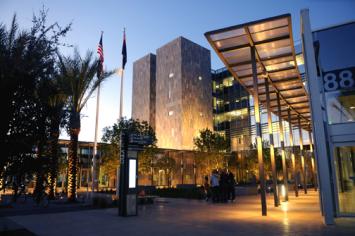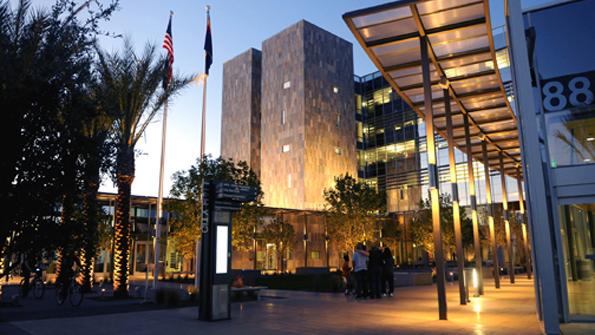America’s Crown Communities 2011
What is in this article?
- America’s Crown Communities 2011
- Schools Recycling Partnership Program (Cathedral City, Calif.)
- Chandler City Hall (Chandler, Ariz.)
- Wastewater Collection System and Wastewater Treatment Plant Expansion (Pharr, Texas)
- Vacant Property Management Strategy (Philadelphia)
- City Hall Fellows (San Francisco)
- Health District Consolidation (Summit County, Ohio)
Chandler City Hall (Chandler, Ariz.)
 A central part of Chandler, Ariz.’s focus on revitalizing the city’s historic downtown was to build a new headquarters for city operations. The planning started more than 20 years ago when leaders “made a conscious decision to rent space downtown to help spur economic development,” says Mayor Jay Tibshraeny. “While doing so, we set aside one-time dollars for the construction of a permanent city hall. This move created an employment mass for the downtown area, and then delivered a city hall residents can be proud of and a place where most all municipal services are centrally located.”
A central part of Chandler, Ariz.’s focus on revitalizing the city’s historic downtown was to build a new headquarters for city operations. The planning started more than 20 years ago when leaders “made a conscious decision to rent space downtown to help spur economic development,” says Mayor Jay Tibshraeny. “While doing so, we set aside one-time dollars for the construction of a permanent city hall. This move created an employment mass for the downtown area, and then delivered a city hall residents can be proud of and a place where most all municipal services are centrally located.”
The city hired Phoenix-based SmithGroup to design the city hall, redeveloping a nearly vacant site. The design strategy began with the idea of creating connections to the city’s existing civic campus and historic downtown core, says Mark Roddy, design principal for SmithGroup. It also focused on reinforcing pedestrian-friendly activity around a nearby park and creating an “urban edge” along all the bordering streets to promote connection and activity throughout the downtown area.
Chandler’s new city hall has spurred the downtown development it aimed for — more than 10 new businesses have opened nearby since construction began. It also has built community pride, with several thousand people taking tours through the building since it opened, Tibshraeny says.
But perhaps the project’s biggest accomplishment has been its economic impact during the “Great Recession.” Because of funding reserves in place and the construction’s timing, the city did not have to borrow money or issue bonds. The bid and build-out costs were $47 million versus the $51 million expected cost because of competitive pricing and the low cost of commodity materials during the recession.
“Building during a recession saved millions of dollars and created hundreds of construction jobs,” Tibshraeny says. At its peak, the project employed approximately 400 local tradesmen, and the project invested approximately $55 million into the local economy.
















